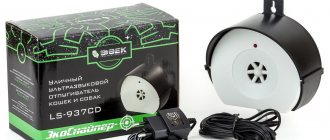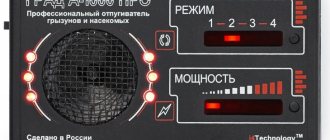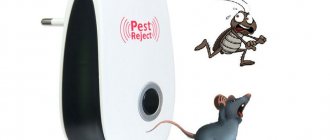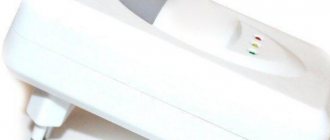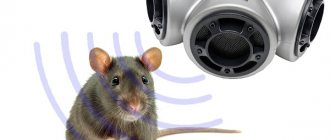Today, there is still ongoing debate between ordinary consumers and manufacturers of ultrasonic rodent repellers regarding how effective ultrasound is in general against rats and mice. On the one hand, it has been scientifically proven and confirmed by many people in practice that ultrasound really helps against rats: a good repeller, when used correctly, allows you to drive rodents away from a fairly large area, protecting food there and the sanitary situation in general.
On the other hand, there are very many cases when the ultrasonic agent did not provide the desired effect and turned out to be simply a useless dummy (sometimes quite expensive) - the pests remained in the protected area. Moreover, many reviews report that rats sometimes seem not to pay attention to the working device at all - they calmly feed and move very close to the seemingly working device. Here it is time to conclude that the drug does not have any effect on the behavior of rodents.
So where is the truth? Does ultrasound help in the fight against rats and mice, or is it just another advertising gimmick? And if ultrasound really works, then how to use it correctly to get the desired effect? Let's find out...
Ultrasound in the life of rodents
Let's start with the fact that ultrasound refers to sound vibrations with a frequency above 20,000 Hz, that is, above the hearing threshold of the average person. Humans cannot hear ultrasounds, but many other animals perceive them quite normally.
On a note
Only a very few, especially sensitive people, are able to hear sound with a frequency just above 20 kHz. Such high-pitched sounds are perceived as a very thin, barely audible squeak.
The gray rat can perceive sounds with a frequency of up to 40 kHz, the house mouse - up to 100 kHz. That is, what is absolutely inaudible for humans is important sound information for these animals.
What is useful to know about ultrasound:
- The nature of ultrasound is no different from the nature of other sounds, which means it has the same characteristics: volume (power), directionality, ability to be reflected and absorbed. A small ultrasonic repeller, powered by a small AA battery, a priori cannot generate powerful ultrasonic radiation, and loud advertising statements about the amazing effectiveness of such “babies” in areas of several hundred square meters can only cause a smile;
- Any sounds, including ultrasound, can convey different information to an animal - neutral, unpleasant, frightening (a message about danger). That is, not every ultrasound will scare a rat, just as people do not attach significance to every sound;
- Rats, mice and other rodents actively use ultrasound for communication - for example, they use it to transmit signals of help or danger to each other.
This is interesting
Guinea pigs are one of the most vocal among rodents; they scream often and loudly in the ultrasonic range (inaudible to humans). The most silent are mice; they use ultrasound only in danger or in stressful moments (for example, during fights). Male mice also “sing” in the ultrasonic range, attracting females. The complexity of their songs is similar to that of birds. Interestingly, newborn rodent cubs actively communicate with their mother using the language of ultrasound.
All this means that it is technically possible to create a device that will generate ultrasound that creates discomfort or anxiety for rodents. Animals will avoid places where they hear such sounds, and therefore an entire room can be protected from them.
And the first thing you need to know to obtain such an effect is the optimal frequencies at which the corresponding ultrasonic installation should operate.
What frequency ultrasounds are best at repelling rats and mice?
Based on the results of numerous experiments in laboratories, scientists have identified frequency ranges that are frightening for rats and mice. So, when they feel pain, rats make sounds in the range of 25-28 kHz, when they smell a cat - in the range of 32-33 kHz. When frightened, mice “squeak” in several ranges, the highest of which is at 96 kHz.
However, experiments have shown that attempts to frighten rodents with ultrasound in narrow ranges are usually unsuccessful, even with the most careful implementation. Even if the desired effect is initially achieved, then the rodents quickly get used to the source of the stimulus.
In addition, ultrasound in a narrow range, effective against rats, will not frighten mice, and vice versa. For these reasons, ultrasonic devices often operate on the principle of constant and random frequency changes. In this case, with a randomly changing frequency, the device will produce sounds that are truly uncomfortable for the animals, which means that repelling is highly likely to be successful.
This is the principle of operation of all effective ultrasonic devices against rats and other rodents: the device constantly changes the frequency of ultrasonic radiation. However, this is not implemented in all devices available on the market today, which is one of the reasons for their ineffectiveness in practice. Moreover, some Chinese rodent repellers, instead of emitting ultrasound, squeak monotonously in the audible range - there is no need to even talk about effectiveness here.
On a note
Given the popularity of ultrasonic rodent repellers, people sometimes become interested and ask consultants in specialized stores about ultrasonic rat traps and mouse traps. So, it is important to understand that there is no commercially available ultrasonic device for catching rodents. Ultrasound does not kill rats, but can only scare them away (if the device is implemented correctly).
Beware of counterfeits and aggressive marketing
Cheap super-pupper repellers are just aggressive marketing, selling something that really costs nothing. Don't be fooled by the bright wrapper. Really working devices can be counted on one hand. Read articles, watch reviews on YouTube - see for yourself. Sonic rodent repellers (they make audible sounds, such as meowing) are also not effective. Yes, such a device will scare away the mouse a couple of times. But then the animal will get used to it, understand that there is no danger, and will stop paying attention to it.
Main characteristics of ultrasonic rodent repellers
Here are the main performance characteristics of ultrasonic repellers that you should pay special attention to:
- Protected area. The parameter shows in what area around the device rats and mice will not appear. It should be borne in mind that many manufacturers often greatly overestimate this parameter. In addition, if there is a lot of soft furniture in the room that absorbs ultrasound, as well as obstacles from which the radiation will be reflected, then the actual effective area may be several times smaller;
- The sound pressure level, which determines how intense the ultrasound the device generates and how strongly it will affect animals. The higher this value, the greater efficiency can be expected from the device (ideally the sound pressure level should be on the order of 100 dB or higher);
- Directional pattern of emitted ultrasound. In simple terms, this characteristic indicates how widely sound will travel around the device. The 360° radiation pattern means that the sound travels around the entire device. Testing of many rodent repellers on the market has shown that many manufacturers mercilessly overestimate this parameter;
- Frequency range. This indicator tells us within what limits the ultrasound frequency will change during operation of the device. Practice shows that the wider this spectrum, the less often the device misfires. In addition, devices with a wide spectrum of radiation are effective not only against rats and mice, but also against many other animals (shrews, mole rats, moles, even dogs). A good option is to operate the device in the frequency range of 20-80 kHz.
It is also useful to read: How to poison rats and mice to quickly get rid of their presence in the house
Additionally, when choosing a device, it is useful to consider:
- What does it feed from? If the repeller is powered by batteries, then the emitted ultrasound will be of low power;
- How much does the device cost? Devices with a price below 1000 rubles. for the most part they turn out to be completely ineffective;
- How the device is positioned. If the description of the device indicates that it is not just an ultrasonic repeller, but also a magnetic resonance and electromagnetic one, and it repels not only rodents, but also cockroaches, mosquitoes and flies - this is a sure sign of a pacifier.
The main problem when choosing an ultrasonic rat and mouse repeller is the inability of an ordinary person to check the characteristics declared by the manufacturer. The point here is that special measuring devices are needed to monitor parameters, and it is impossible to simply hear ultrasound and estimate the sound pressure level. Externally, a working device does not show itself in any way.
Unscrupulous manufacturers often take advantage of this and indicate on their devices parameters that are far from reality. As a result, there is a risk of buying, instead of a reliable device, either an ineffective device, or a completely useless Chinese box with a battery-powered LED.
What in practice?
In real working conditions (for example, in a granary), a good device will almost instantly cause rats and mice to run away from the place where the repeller is turned on. When testing on laboratory mice, it is noted that they begin to rush around the cage, run to the farthest corner, throw food, and try to hide.
The practice of using ultrasonic devices shows that in many cases, when these devices are operating, rats stop entering protected premises or leave them if they previously lived in them permanently. But this is only relevant for effective devices, provided they are used correctly.
What do special studies say about the effectiveness of ultrasound against rats?
The results of several practical experiments on “wild” basement rats are known. The essence of the experiments was as follows:
- In one of the rooms of an abandoned building infested with rats, rat traps were installed with bait, but with the brackets removed. These rat traps did not kill the animals or even catch them, but made it possible to record the fact that a rat approached the bait. The rat trap worked, which means the animal was definitely approaching it;
- First, the number of rat traps triggered in the absence of the device was recorded;
- Then the test repeller was turned on in the room for the whole night, and the next morning the number of activated rat traps was assessed.
The more effective the repeller was, the fewer rat traps were triggered when the device was operating compared to the period without the repeller (the rats ran around the room less).
In such experiments, many devices were tested, and based on the results, it became clear that there are both quite effective professional products on the market and outright fakes that do not repel rats at all. When some devices were operating, the rats did not approach the baits at all, while near other devices they calmly fed and went about their “own business.”
On a note
In laboratory studies, it was found that rats, constantly exposed to ultrasound and unable to hide from the signals, were in a state of continuous stress, refused to eat and died after some time.
Here are just some of the fairly well-proven ultrasonic rodent repellers:
- Bioguard;
- Chiston-2;
- Chiston-2 PRO;
- TM-315;
- WK-0600;
- UZU-03;
- Range;
- Tornado-800.
Review
“To be honest, I was afraid to turn on the ultrasound in the chicken coop. I even thought about ordering a special safe trap to catch the rats. But then I took a risk. And it’s normal, the chickens didn’t seem to hear anything at all. And the rats disappeared, I haven’t seen them for a month now...”
Alexey, Barnaul
Homemade option
Some people suggest building a rodent repeller with your own hands. It will require an old speaker from a speaker and a battery. The craftsmen who make such devices assure that homemade repellers are in no way inferior in efficiency to factory-made devices. But if we talk about their safety for humans, then there is no guarantee that the device is completely harmless. Do not forget that factory repellers undergo special testing and certification before entering the market. And doctors state that an incorrectly selected ultrasound frequency can lead to the development of various diseases and has a detrimental effect on the functioning of the nervous system.
Why do ultrasonic devices sometimes not work?
The main reason that fighting rats with ultrasound often does not have an effect in practice is the low quality of the devices and the discrepancy between their characteristics and those declared by the manufacturer. Simply put, a person can buy what seems to be not the cheapest device, but in fact it either doesn’t work at all, or the signals are too low-power, or rats quickly get used to them.
As a general rule, the cheaper the repeller, the less likely it is to work. Practice shows that if the price of a device is below 1000 rubles, then protection against rats with its help will be ineffective.
It is also useful to read: Rules for choosing the best ultrasonic mouse and rat repeller
But there may be other reasons for the lack of results:
- Incorrect use of the device, when the signal from it can be actively absorbed by surrounding objects, or the device itself is turned on in the wrong place where it should scare rats and mice (for example, it is turned on in the basement of a large cottage with the hope that the device will expel rodents from all rooms of the house, including the attic);
- Rodents getting used to ultrasound, even if its frequency is constantly changing, is also possible. If rats, occasionally entering the territory protected by the device, regularly find food here, do not suffer losses (do not get caught in rat traps), and do not feel other dangers (for example, the smell of a cat), then they gradually get used to the fact that such “raids” are safe , but the ultrasound itself can be tolerated. When using powerful high-quality devices, this rarely happens - mainly with long-term continuous use of the repeller.
However, in practice, the main reason for skepticism and negative reviews about ultrasonic rodent repellers is attempts to get rid of pests using the cheapest devices (sometimes even in the form of a key fob), which have virtually no effect on rats.
Recommendations for choosing a model
A properly selected device is the key to its effective operation. When choosing a model, you need to consider the following parameters:
- type of pest;
- type of room;
- area of territory that needs to be freed from rodents.
Most emitters are designed specifically to exterminate a particular pest. This will narrow down your search for a suitable option.
What rooms is it suitable for?
Ultrasonic emitters are used in almost any area: in an apartment, house and office, in a garden and country house, in a garage and warehouse, in shops and factories. You should select a device based on the area of the room. You should carefully look at the impact radius markings.
Device requirements
The devices do not require special maintenance. It is enough to remember the features of ultrasound, which is not able to overcome obstacles in the form of walls and dense tissues. Therefore, it is necessary to install emitters as often as possible (1 or more devices per room, depending on the area).
Is ultrasound safe for humans and pets?
For humans, ultrasound of not very high power (up to about 10 W) is relatively safe. Only very powerful repellers can have an effect, although the person does not understand that this is happening. For example, under the influence of ultrasound and prolonged use of the device in residential premises, people sometimes develop headaches. Therefore, ultrasonic repellers are not recommended for long-term use in residential areas. Moreover, they cannot be used in bedrooms.
Many pets can hear ultrasound well, and it can negatively affect their condition. Domestic rodents - rats, mice, hamsters - react most acutely to the signals of the device. Dogs and cats can also hear the device's signals well, and in some cases these sounds can put them in a state of stress.
On a note
Some Chinese battery-powered ultrasonic repellers are described in advertising as being completely safe for any pet. And this is really close to the truth - due to their insignificant power, they do not have a noticeable effect on either domestic animals or rodents.
Choosing an effective device
According to the test results and taking into account the feedback of experts, the following models, for example, are quite reliable ultrasonic agents for rats and mice:
- Chiston-2 PRO - its price is approximately 3000 rubles, frequency range 20-70 kHz, protected area 450 sq. m;
- Bioguard - price about 4,500 rubles, protected area 850 sq. m;
- Chiston-2 - costs approximately 2,500 rubles, protected area is 300 square meters. m;
- Tornado-800 - price about 3,500 rubles, protected area 800 sq. m;
- TM-315 - 6500 rubles, protected area 750 sq. m.
Also, in many cases, WK-0600, Elektrokot and other devices with comparable technical characteristics turned out to be effective.
Review
“I became interested in the question when a huge number of rats were discovered at the dacha. I read in magazines about an electric cat, this thing costs 2000 rubles. Working area 200 squares. I don’t know how the rats felt there, but standing with the electric cat turned on bothered me, as there was an unpleasant squeaking sound. The rats are gone, but the sensations from the device are ambiguous, the squeaking is very unpleasant...”
Pavel, Moscow
Weitech
Devices powered from a 220V network consume energy economically. They generate ultrasound waves with a frequency of 20 kHz and higher. The line includes models for domestic needs, samples for large industrial and civil facilities. They have built-in light indicators. For the first 15-20 days, the devices should function almost continuously. Every 3 days they are turned off for 1-2 hours. Then, for prevention, it is enough to do this at night. EcoSniper Ultrasound and combined devices, some equipped with an additional air ionization function, can be used as night lights. Economical, powered from a 220V network, silent, equipped with an indicator. The instrument generator switches frequencies automatically. Suitable for apartments, houses, shops, warehouses, offices. There are models for vehicles.How to properly use ultrasound against rats
Ultrasonic repellers are quite easy to use. The device is plugged into an outlet in the room that is planned to be protected from rodents, and it is important to ensure that nothing interferes with the propagation of sound. Ideally, there should be no large objects or furniture at a distance of 2-3 meters from the device, since they will all dampen and reflect sound vibrations.
It should be taken into account that the protected area for each device is indicated without taking into account the attenuation of ultrasound by interior items, walls, floors, and ceilings. This means that if you place the repeller in the middle of a large workshop, having approximately the same area as indicated on the device, then ultrasound will be more or less effective in almost the entire room. The device will no longer protect many small rooms with the same area, but separated by even thin walls, since ultrasound does not penetrate walls.
It is recommended to turn on the repeller only at times when there are no people in the room and there is a high probability of rats appearing. For example, the device can work 2-3 times a day for 2-3 hours, or only at night. In this case, the risk of pests becoming accustomed to the sound will be minimal.
So, a little summary:
- Ultrasound can indeed repel rats and mice if used correctly;
- The main reason why ultrasonic repellers often turn out to be ineffective is the purchase of useless low-power “toys” instead of quality devices, and then premature conclusions that “ultrasound does not work.”
If you have personal experience using ultrasonic repellers in the fight against rodents, be sure to share the information by leaving your review at the bottom of this page. Did this or that device help you, what was it called, did it create discomfort during work, how did the rats (or mice) react - in general, any practical information will be interesting.
